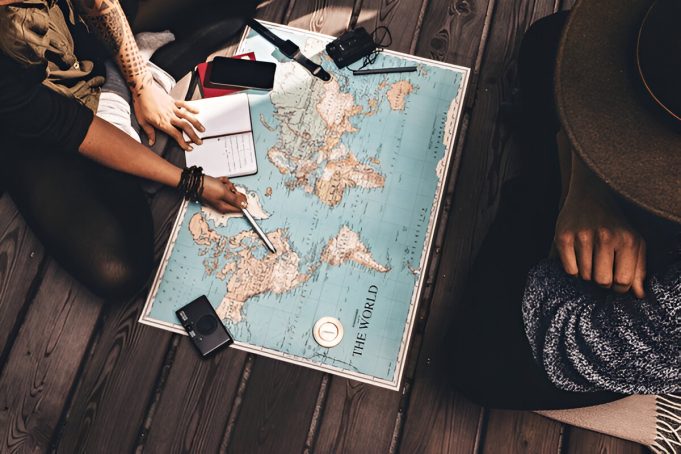The Spark of Adventure: Turning a Travel Dream into a Tangible Plan
The idea of an international trip often starts as a whisper. It’s a photo you see online, a story a friend tells, or a scene in a movie that plants a seed of wanderlust. Suddenly, you’re not just daydreaming; you’re wondering, “Could I actually go there?” The answer is a resounding yes. However, the chasm between that initial spark and stepping off a plane in a new country can feel vast and intimidating. The logistics, the cost, the paperwork—it can be enough to make anyone put the dream back on the shelf.
Step 1: The Foundation – Where, When, and How Much?
Before you can book a single flight or hotel, you need to build the foundation of your trip. These initial decisions will shape every other choice you make.
Choosing Your Destination
The world is massive, so narrowing it down is key. Ask yourself some fundamental questions:
- What kind of experience are you seeking? Relaxation on a beach, adventure in the mountains, cultural immersion in a bustling city, or historical exploration of ancient ruins?
- What’s your comfort level? For a first trip, you might prefer a destination where English is widely spoken or that has a well-developed tourist infrastructure (e.g., Western Europe, Australia). Or, you might be ready to dive into the deep end somewhere more off-the-beaten-path.
- When can you go? The time of year will heavily influence your options. Research the weather patterns for your potential destinations during your travel window. Shoulder seasons (the months just before and after peak season) often offer a great balance of pleasant weather and fewer crowds.
Setting a Realistic Budget

Your budget is the most critical component of your plan. It’s not about being restrictive; it’s about being realistic so you can travel without financial stress. Break it down into categories:
- Major Transportation: This is primarily your round-trip flight. Use tools like Google Flights or Skyscanner to get a general idea of costs.
- Accommodation: Research the average cost per night for hostels, budget hotels, or Airbnbs in your chosen destination. Multiply this by the number of nights.
- Daily Expenses: This includes food, local transport, and entrance fees for attractions. A common estimate for budget-to-mid-range travel is $50-$100 USD per day, but this varies widely by country. Research specific costs for your destination.
- Activities & Tours: Are there any big-ticket items you want to do, like a scuba diving course, a multi-day trek, or a cooking class? Budget for these separately.
- Contingency Fund: Always add an extra 10-15% to your total budget for unexpected expenses. A missed train, a medical issue, or a must-have souvenir—you’ll be glad you have this buffer.
Step 2: The Paperwork Trail – Passports, Visas, and Insurance
Navigating the bureaucracy is arguably the least glamorous part of travel planning, but it is the most important. Getting this wrong can stop your trip before it even starts.
Passport Validity
Find your passport. Right now. Check the expiration date. Many countries require your passport to be valid for at least six months beyond your intended date of departure from that country. If your passport is nearing expiration or doesn’t meet this six-month rule, begin the renewal process immediately. Standard passport processing can take several weeks or even months.
Visa Requirements
A visa is an official document that grants you permission to enter a country for a specific purpose. Whether you need one depends on your citizenship and your destination. A quick search on the destination country’s official embassy or consulate website will tell you the requirements. Some countries offer visa-free travel, some require an e-visa you can apply for online, and others require a more involved application process with an in-person appointment. Do this research early!
Travel Insurance: The Non-Negotiable
If you can’t afford travel insurance, you can’t afford to travel. It’s that simple. A good policy is your financial safety net for a wide range of potential problems, including:
- Medical emergencies and evacuation
- Trip cancellation or interruption
- Lost or stolen luggage and belongings
- Travel delays
Read the policy details carefully to understand what is and isn’t covered. It’s a small price to pay for immense peace of mind.
Step 3: The Booking Phase – Locking in Your Plans
This is when your trip starts to feel real. With your destination, dates, and budget confirmed, it’s time to make your major bookings.
Finding the Best Flights
Start searching for flights 2-3 months in advance for international travel. Use flight aggregators like Google Flights, Skyscanner, or Momondo to compare prices across different airlines. Be flexible if you can; flying on a Tuesday or Wednesday is often cheaper than on a weekend. Consider setting up price alerts for your route to get notified when fares drop.
Choosing Your Accommodation
Your accommodation style sets the tone for your trip. Hotels offer comfort and convenience. Hostels are fantastic for budget travelers and those looking to meet other people. Vacation rentals (like Airbnb or Vrbo) can provide a more local feel and kitchen facilities. Read recent reviews carefully and check the location on a map to ensure it’s convenient for the things you want to do. It’s often wise to book your first and last night’s accommodation in advance, leaving some flexibility in the middle if you prefer a more spontaneous style.
Step 4: Itinerary and Activities – Crafting Your Experience
With the logistical framework in place, you can now focus on the fun part: deciding what you’ll actually do!
Research and Prioritize
Dive into travel blogs, guidebooks, and YouTube videos about your destination. Make a list of all the sights, activities, and restaurants that excite you. Then, group them by location on a map (Google My Maps is excellent for this). This will help you see which attractions are near each other so you can plan your days logically and avoid backtracking.
Build a Flexible Itinerary
Avoid the rookie mistake of over-scheduling every minute of your trip. A good itinerary is a guide, not a strict set of rules. Plan one or two main activities per day and leave the rest of the time open for spontaneous discoveries. Some of the best travel memories come from stumbling upon a hidden cafe, getting lost in a charming neighborhood, or simply sitting in a park and people-watching. Leave room for magic to happen.
Step 5: Final Preparations – Money, Tech, and Packing
The departure date is getting closer! These final steps will ensure you are fully prepared for life on the road.
Managing Your Money Abroad
Relying solely on cash is risky. The best strategy is a combination of methods:
- Credit Card: Use a card with no foreign transaction fees for larger purchases like hotels or nice meals. It offers great fraud protection.
- Debit Card: Use a card with low or no international ATM withdrawal fees to get local currency. It’s almost always cheaper than exchanging cash at the airport.
- Notify Your Banks: Call your credit and debit card companies to inform them of your travel dates and destinations. This prevents them from flagging your overseas transactions as fraudulent and freezing your accounts.
The Ultimate Packing Checklist
Packing light is a skill. You almost always need less than you think. Focus on versatile clothing that can be layered and worn in multiple combinations.
- Essentials: Passport, visas, flight tickets, travel insurance documents, credit/debit cards, and some local currency.
- Clothing: Pack for the climate, focusing on moisture-wicking and wrinkle-resistant fabrics. Always include a rain jacket and a comfortable pair of walking shoes.
- Electronics: Phone, charger, portable power bank, and a universal travel adapter.
- Toiletries & Meds: A small first-aid kit with basics like pain relievers, band-aids, and any personal prescription medications (in their original bottles).
Use packing cubes to compress your clothes and keep your luggage organized. It’s a game-changer.
Step 6: The Final Countdown – Pre-Departure Checklist
In the last 24-48 hours, run through this final checklist to ensure a smooth departure.
- Check in for your flight online.
- Make digital and physical copies of your passport, visas, and itineraries. Keep them separate from the originals.
- Download offline maps, music, podcasts, and movies.
- Charge all your electronics.
- Share your itinerary with a family member or friend back home.
- Do a final weigh-in of your luggage to avoid hefty airport fees.
Conclusion: Embrace the Journey
You did it. The research, the saving, the planning—it has all led to this moment. Planning your first international trip is a journey in itself, one that teaches you about geography, budgeting, and your own capabilities. As you embark on your adventure, remember that things may not always go exactly as planned, and that’s part of the beauty of travel. Embrace the unexpected, be open to new experiences, and savor every moment. The world is waiting for you.







